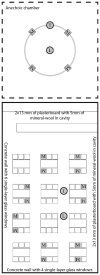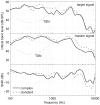An examination of speech reception thresholds measured in a simulated reverberant cafeteria environment
- PMID: 25853616
- PMCID: PMC4762878
- DOI: 10.3109/14992027.2015.1028656
An examination of speech reception thresholds measured in a simulated reverberant cafeteria environment
Abstract
Objective: There is increasing demand in the hearing research community for the creation of laboratory environments that better simulate challenging real-world listening environments. The hope is that the use of such environments for testing will lead to more meaningful assessments of listening ability, and better predictions about the performance of hearing devices. Here we present one approach for simulating a complex acoustic environment in the laboratory, and investigate the effect of transplanting a speech test into such an environment.
Design: Speech reception thresholds were measured in a simulated reverberant cafeteria, and in a more typical anechoic laboratory environment containing background speech babble.
Study sample: The participants were 46 listeners varying in age and hearing levels, including 25 hearing-aid wearers who were tested with and without their hearing aids.
Results: Reliable SRTs were obtained in the complex environment, but led to different estimates of performance and hearing-aid benefit from those measured in the standard environment.
Conclusions: The findings provide a starting point for future efforts to increase the real-world relevance of laboratory-based speech tests.
Keywords: Speech reception thresholds; hearing aids; hearing loss; real-world.
Figures







References
-
- Agus TR, Akeroyd MA, Gatehouse S, Warden D. Informational masking in young and elderly listeners for speech masked by simultaneous speech and noise. Journal of the Acoustical Society of America. 2009;126:1926–1940. - PubMed
-
- ANSI S3.5-1997 Methods for calculation of the speech transmission index. A revision of ANSI S3.5-1969. American National Standard, 1997
-
- Bentler RA, Niebuhr DP, Getta JP, Anderson CV. Longitudinal study of hearing aid effectiveness II. Subjective measures J Speech Hear Res. 1993;36:820–831. - PubMed
-
- Bernstein JG, Grant KW. Auditory and auditory-visual intelligibility of speech in fluctuating maskers for normal-hearing and hearing-impaired listeners. Journal of the Acoustical Society of America. 2009;125:2258–3372. - PubMed
Publication types
MeSH terms
Grants and funding
LinkOut - more resources
Full Text Sources
Other Literature Sources
Medical
